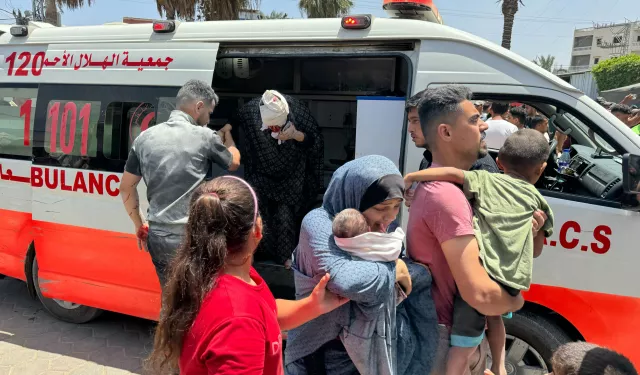The driver was under strict military orders. “Do not stop, no matter what happens,” the Israeli officer told him as he loaded sacks of flour onto his truck.
His instructions were clear—travel five kilometres from the crossing point near Zikim to Gaza City’s northwest, and do not slow down for anyone — or risk being bombed.
“We honked and screamed at people to move away,” the driver told Al Manassa. “But the people were desperate.”
Moments later, dozens were killed. In scenes described by eyewitnesses, at least 45 people were crushed beneath the wheels of humanitarian aid trucks in northern Gaza as they surged forward, trying to grab whatever food they could.
The trucks had been ordered to plough through by the Israeli occupation army, threatening drivers with airstrikes if they stopped before reaching a designated drop-off site.
The tragedy is only the latest chapter in a spiralling humanitarian disaster gripping the besieged Gaza Strip, where starvation is now killing more people than bombs.
Hunger reaches new lows
A tragic toll mounted this week as 15 people, including four children, died within 24 hours from hunger and severe malnutrition, Gaza's Health Ministry reported. This devastating figure brings the death toll from starvation since the onset of the war on Gaza to 101, 80 of them children.
According to the ministry, the past two months have also seen an unprecedented surge of 45 new cases of acute flaccid paralysis.
With Gaza’s health system decimated by relentless war and siege, authorities are unable to confirm whether the paralysis is linked to polio or Guillain-Barré syndrome, both of which require laboratory testing and neurological assessments unavailable due to the healthcare system’s catastrophic deterioration.
The ministry attributes this surge to the dire health and environmental conditions endured by residents, including widespread water contamination, collapsed sewage systems, accumulating waste, and the rampant spread of infectious diseases.
These challenges are exacerbated by rampant malnutrition and weakened immunity, grim consequences of the starvation policy imposed by the Israeli occupation.
Underscoring this looming catastrophe, more than 100 non-governmental organizations today issued a stark warning of “mass famine” across the Gaza Strip. This alarm amplifies mounting international pressure on Israel over the unyielding suffering in the besieged and devastated Palestinian enclave.
Hospitals at breaking point
Further worsening Gaza’s humanitarian plight, Gaza’s Health Ministry reported that six medical centers in the north—including Al-Khidma Hospital and Al-Shati Clinic—had shut down due to critical fuel shortages. This occurred after Israeli authorities blocked fuel transfers, even those coordinated by WHO.
Now, major hospitals like Shifa and Al-Ahli Baptist face imminent closure within 48 hours unless fuel access is immediately restored.
Meanwhile, hospitals in northern Gaza have received more than 140 bodies in recent hours, among them 45 people who died while attempting to collect food from humanitarian aid trucks, particularly in the areas of Zikim and Al-Sudaniya.
The aggression continues
Even as famine casts its grim shadow, the relentless aggression raged on. On Tuesday night, the Israeli occupation army carried out four separate airstrikes across Gaza City, killing approximately 40 people and wounding over 70, according to a source at Shifa Hospital. Twenty of the injured remain in critical condition.
In Deir al-Balah, medical teams at Al-Aqsa Martyrs Hospital retrieved eight bodies after Israeli forces withdrew from the eastern outskirts following a three-day incursion.
Meanwhile, the Qassam Brigades, the military wing of Hamas, announced that it had targeted an Israeli tank and armored vehicle with homemade projectiles southeast of Deir al-Balah.
Concurrently, Israeli military vehicles pressed their early morning incursion into the city’s southern section amid heavy fire, forcing families to shelter indoors, according to two eyewitnesses who spoke to Al Manassa.
Meanwhile, Islamic Jihad’s Al-Quds Brigades announced they had lost contact with the unit holding Israeli soldier Rom Breslavsky. This development comes amidst reports of an Israeli army encirclement of the area where the unit was thought to be located. The group stated in a Telegram post, “As of now, we do not know their fate.”
The Palestinian resistance group is holding around 20 Israeli captives alive, in addition to 38 bodies. All were captured during the October 7 Operation Al-Aqsa Flood, which was followed by the ongoing Israeli aggression.
On March 18, Israel resumed its devastating military campaign on Gaza. The assault follows a broken cease-fire deal, brokered in January, that was meant to end with the exchange of captives and a full Israeli withdrawal.
Since then, Israel has kept border crossings shut, relentlessly denying entry to humanitarian convoys.
With the escalating human toll, cease-fire efforts remain ongoing with no immediate deal in sight. Mediators from Egypt, Qatar, and the US are engaged in talks, with a proposal of a 60-day halt to hostilities on the table.
Yet, for Gaza’s trapped population, the suffering continues unabated.
